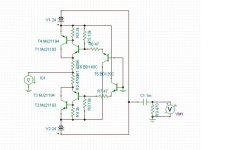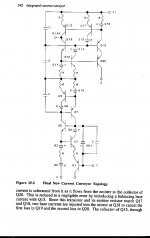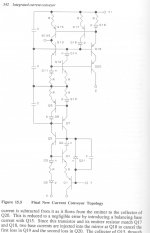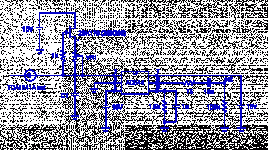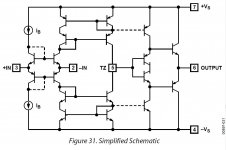And the bigger the bjt the slower / more non linear it is.
There is an art to picking the right device for a particular place in this
circuit and running it at the right current.
Z
....and my silliness is once again lost on the populace at large... sigh.
but, to further the progress of technology and the conquest of nature in all her glory, here is a little something I cooked up in simland. I don't claim nuttin' good about it. Sim'd THD is 6x10^-5% for 6mA input. Just something for the bong.
mmmm, time to get out that steel polish and shine those babies up!
Attachments
There is an art to picking the right device for a particular place in this
circuit and running it at the right current.
Z
can we simple mortals, have a glance at your art, please enlighten us with your divine knowledge.

can we simple mortals, have a glance at your art, please enlighten us with your divine knowledge.
Divine knowledge - too funny
Just use common sense.
Only use large geometry / high current bjts where they are absolutely
necessary - this will be in very few places if you think it through.
Sometimes you will be better off paralleling 2 x slightly smaller devices of
moderate current (337).
Where there is large voltage swing look for super low Cob / linear beta
devices. Sanyo have a very good range. Also 2SA1360/SC3423 are very
good for the 'helpers' that swing in voltage.
If you are going to do an IV for Sabre in mono mode where Z out = 98 ohms
at 16mA swing this will really require some fine tuning of current versus BJT
type etc. It will push an open loop design to the max - especially if you
do it without the CFP pairs.
I suppose I've played that tape before
 __
__
cheers
Looks like Wadia aren't sitting on their hands as far as I/V stages go.
Wadia Digital
"Wadia Swift Current Technology
The series 1 Upgrade, which will supercede the highly-regarded Wadia 860, is the first to use the company’s patented SwiftCurrent IC. This proprietary circuit, first introduced in the Wadia PowerDAC digital amplifier last year, performs the sonically critical current-to-voltage conversion with no negative feedback, resulting in demonstrably superior sound quality.
Conventional digital-to-analog converters perform current-to-voltage (I/V) conversion using feedback circuits based on operational amplifiers. Because the signal from the DAC chip consists of a series of step changes, the distortion introduced by this feedback circuit is a significant limitation on sonic performance.
In contrast, the SwiftCurrent circuit performs this I/V conversion with Wadia’s patented current-conveyor integrated circuit (IC) that eliminates feedback. This bipolar IC consists of an innovative connection of Wilson current mirrors, an emitter degeneration compensation scheme to optimize transient response and stability, and a novel current mirror arrangement to enhance output impedance."
BTW Sergio how is yours going? have not heard anything for a while?
Cheers George
Wadia Digital
"Wadia Swift Current Technology
The series 1 Upgrade, which will supercede the highly-regarded Wadia 860, is the first to use the company’s patented SwiftCurrent IC. This proprietary circuit, first introduced in the Wadia PowerDAC digital amplifier last year, performs the sonically critical current-to-voltage conversion with no negative feedback, resulting in demonstrably superior sound quality.
Conventional digital-to-analog converters perform current-to-voltage (I/V) conversion using feedback circuits based on operational amplifiers. Because the signal from the DAC chip consists of a series of step changes, the distortion introduced by this feedback circuit is a significant limitation on sonic performance.
In contrast, the SwiftCurrent circuit performs this I/V conversion with Wadia’s patented current-conveyor integrated circuit (IC) that eliminates feedback. This bipolar IC consists of an innovative connection of Wilson current mirrors, an emitter degeneration compensation scheme to optimize transient response and stability, and a novel current mirror arrangement to enhance output impedance."
BTW Sergio how is yours going? have not heard anything for a while?
Cheers George
I found this post,george
http://www.diyaudio.com/forums/digital-source/35176-wadia-swift-current.html#post407456
http://www.diyaudio.com/forums/digital-source/35176-wadia-swift-current.html#post407456
Correct. The PA630 (and the '630A, which has connections for dditional FET drain followers at the output) was taken off the market a couple of years ago after the designer sold the rights and his remaining chips to Wadia. There have been at least two publications in EW/WW, plus several in the trade press. There is also a full chapter describing these chips in the book "Analog IC design, the current mode approach".
If you need info like internal schematics etc, drop me an email.
Jan Didden
Last edited:
In contrast, the SwiftCurrent circuit performs this I/V conversion with Wadia’s patented current-conveyor integrated circuit (IC) that eliminates feedback. This bipolar IC consists of an innovative connection of Wilson current mirrors, an emitter degeneration compensation scheme to optimize transient response and stability, and a novel current mirror arrangement to enhance output impedance."
hmm as usual the claims of no feedback are smoke and...mirrors. conveniently deeming degeneration not part of the feedback network.
it still sounds very interesting Jan, so keen to see your schematics.
degeneration is feedback, thats all i'm saying, 'no feedback' is a marketing term. that doesnt mean it cant be an interesting circuit all the same
the thing is full of local feedback/degeneration, its pretty darn cool though
it has no global negative feedback, I just wish that was the term people used, but they almost never do.
thanks for the scheme BTW, another one filed for later.
the thing is full of local feedback/degeneration, its pretty darn cool though
it has no global negative feedback, I just wish that was the term people used, but they almost never do.
thanks for the scheme BTW, another one filed for later.
Last edited:
Well I don't know, how can you learn anything with your mind already firmly made up
But here goes.
jan
WRT Wadia I-V, It's a pretty complex circuit that doesn't really bring a huge
amount of linearity to the table. It won't come close to the circuit in this
thread.
With careful design, a lot simpler [open loop I-V's can do aswell or better
than the Wadia.
It's also arguable that it is a true open loop design as there is + feedback
used to iron out IP BJT non linear emitter resistance.
I found an article from wireless world here.
Index of /Wireless-World-Stuff
PA630 looks not so complex circuit, but just a CC1 with buffer.
Index of /Wireless-World-Stuff
PA630 looks not so complex circuit, but just a CC1 with buffer.
BTW I have had very good results with the AD844, another CCII with buffer. In contrast to the PA630 it is a balanced circuit instead of single ended, although that only manifests itself in somewhat better DC characteristics.
I've used the AD844 in CCII role (open loop) in power amp feedback/error correction circuits with excellent results.
jan
I've used the AD844 in CCII role (open loop) in power amp feedback/error correction circuits with excellent results.
jan
Funny you should bring up the AD844 Jan.
I found this circuit of Pedja Rodic's (attached) and used it as is (NO FEEDBACK) and it worked a treat, best opamp based I/V so far by a long way, it blew the OPA627 completely away I though it would never be beaten except for a discrete I/V of some sort. (And I’ve tried just about every opamp out there)
I used it without feedback as per the diagram and was very very happy. Used with TZ as he has it 1.5K with 1000pf to ground, I think this gives a 1st order rolloff –3db @100khz.
Does the 1.5k resistor have a bearing on what input resistance the dac (PCM1704 in my case) sees?
Because I changed the resistor for 2.2k to get some more gain but this time with a 260pf cap –3db @ 270khz (still all nice and stable with a bit more gain) still very very good.
But I had the feeling it was puchier and more dynamic with the 1.5k resistor even though I had less gain. I feel that the input loading for the PCM1704 is better with the 1.5k than the 2.2k resistor or am I imagining things?.
Cheers and thanks for your input George
I found this circuit of Pedja Rodic's (attached) and used it as is (NO FEEDBACK) and it worked a treat, best opamp based I/V so far by a long way, it blew the OPA627 completely away I though it would never be beaten except for a discrete I/V of some sort. (And I’ve tried just about every opamp out there)
I used it without feedback as per the diagram and was very very happy. Used with TZ as he has it 1.5K with 1000pf to ground, I think this gives a 1st order rolloff –3db @100khz.
Does the 1.5k resistor have a bearing on what input resistance the dac (PCM1704 in my case) sees?
Because I changed the resistor for 2.2k to get some more gain but this time with a 260pf cap –3db @ 270khz (still all nice and stable with a bit more gain) still very very good.
But I had the feeling it was puchier and more dynamic with the 1.5k resistor even though I had less gain. I feel that the input loading for the PCM1704 is better with the 1.5k than the 2.2k resistor or am I imagining things?.
Cheers and thanks for your input George
Attachments
Last edited:
again, how is that No Feedback? conveniently thinking of local and internal mechanisms as something other than feedback does not make it so. transistors inherently have feedback, it cannot be switched off no matter how you arrange them.
QSP, FYI - and you -should- know this by now:
zero FB = no global or inter-stage FB. Usually means no local FB but in the
case of the Wadia CCT and this threads I-V there are small amounts of + FB.
Get used to it, that's the terminology that has evolved and we don't need
another 100 posts discussing the fact that an EF has 100% FB etc etc.
We -all- know what you are talking about, it's just an accepted terminology,
right or wrong.
OK, no global feedback.
Whatever it's got it's got magic like there's no rev limiter, and I have no idea what the distortion is but it sounds distortionless, it presents my cd's in a totaly different way than I've ever heard them.
I would love to know what the input impedance is configured this way, but I suppose only Mr Gilbert the designer for ADI would know has he only knows the whole circuit.
All other opamps for I/V sound a little different tonally to each other, but this AD844 "with no global feeback" has made my whole cd collection a new listening experience.
Cheers George
Whatever it's got it's got magic like there's no rev limiter, and I have no idea what the distortion is but it sounds distortionless, it presents my cd's in a totaly different way than I've ever heard them.
I would love to know what the input impedance is configured this way, but I suppose only Mr Gilbert the designer for ADI would know has he only knows the whole circuit.
All other opamps for I/V sound a little different tonally to each other, but this AD844 "with no global feeback" has made my whole cd collection a new listening experience.
Cheers George
- Status
- This old topic is closed. If you want to reopen this topic, contact a moderator using the "Report Post" button.
- Home
- Source & Line
- Digital Source
- dac I/V convertion with very low distortion
